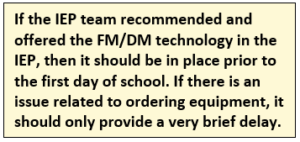 Question from the field: I have a student whose IEP calls for an FM system. However, the system is not in place, and we are more than half way through the school year. What can I do as the teacher of the deaf to help get this student their system?
Question from the field: I have a student whose IEP calls for an FM system. However, the system is not in place, and we are more than half way through the school year. What can I do as the teacher of the deaf to help get this student their system?
Why FM/DM Systems?
Many districts are now referring to FM/DM equipment as HATS, or Hearing Assistive Technology Systems. The use of HATS in the educational setting not only provides better access to the linguistic information, but as a result can help with development of speech and language skills, increase incidental learning, and can help with social skills in the classroom.
A powerful teaching tool that demonstrates the benefits of HATS in the educational setting as well as the difficulty without it can be viewed on YouTube (Hearing Loss in the Classroom, St. John’s Medical Center1). This can be shared with families and educators alike to improve awareness of what a difference it can make to improve the signal to noise ratio.
HATS includes any of the following components2:
- Teacher transmitter or teacher microphone: This is worn by the teacher and is synced with the students’ personal receivers. It can easily be muted and us muted as needed throughout the day.
- Personal receivers (sometimes called boots): These are attached to the student’s hearing aids or cochlear implant processors.
- Classroom sound-field systems: This allows the teacher and students to use a microphone(s) and have their voices amplified above the ambient noise for all students including the student with hearing loss to have better access.
- Pass-around microphone: This is used by peers to provide access for the student during class discussions and peer-to-peer communication. If there is a sound-field system, then the student with hearing loss would also use the pass-around microphone. While a sound-field system typically does not provide a sufficient signal-to-noise enhancement for students with hearing loss2, with planning, personal HAT devices can often work in conjunction with sound-field classroom amplification systems. When there is a sound-field system and the student with hearing loss uses the microphone, just like class peers, the student is not singled out, thus supporting them socially, and enables them to use their auditory feedback loop in order to monitor and correct their own speech production.
Timing is Essential for FAPE
 All placement, services, and goals offered in the IEP are effective upon signature by the parent or legal guardian and should be implemented immediately. A court case4 ruled against a school district who delayed the repair of a student’s FM system, even through the student maintained good grades saying, “his maintenance of good grades was due to his own diligence. The school was found to have denied the student FAPE and violated section 504.
All placement, services, and goals offered in the IEP are effective upon signature by the parent or legal guardian and should be implemented immediately. A court case4 ruled against a school district who delayed the repair of a student’s FM system, even through the student maintained good grades saying, “his maintenance of good grades was due to his own diligence. The school was found to have denied the student FAPE and violated section 504.
If the IEP team recommended and offered the FM/DM technology in the IEP, then it should be in place prior to the first day of school. Of course, if equipment needs to be ordered and the student is starting school immediately, then every effort should be taken to ensure the student has appropriate auditory access to everything being said in the classroom as soon as possible. Different school districts differ in the way in which they acquire technology. In speaking with and working directly with the companies that supply these systems, there is no reason for there to be a month-long delay (let alone half of a school year). Some companies are also willing to send a system for the child to use as a “loaner” device while the district is going through their procedural process to obtain the equipment offered in the IEP.
The Barrier of Lack of Audiology Expertise
Students who are eligible for specialized instruction as Deaf/Hard of Hearing comprise one of the populations considered under low incidence disabilities. The discussion of low incidence equipment is one that is unique to students whose eligibilities require “personnel with highly specialized skills and knowledge … to receive early intervention services or a free appropriate public education”5 The Educational Audiologist is the service provider responsible for ordering assistive hearing technology6. Sometimes, school administration will put pressure on the teacher of the deaf/hard of hearing or the speech language pathologist to obtain HAT systems for students, which is inappropriate as recommending HAT equipment is outside the role and responsibility of both of these professionals.7 If you are in a circumstance where your district does not have an Educational Audiologist on the team, or if there is a lack of audiology service time to ensure prompt provision of the equipment, it is important for you to approach the administrator to find a solution. A clinical audiologist, especially one specializing in pediatrics, has the expertise to recommend appropriate HAT equipment for use in the school setting.
Be Empowered to Advocate
Facilitating the ordering of the required technology is necessary for your student to receive appropriate access to instruction and classroom communication. As the teacher of students who are deaf/hard of hearing you should feel empowered to let your district know that for your student to spend any time without the FM/DM system is like asking a student in a wheel chair to wait for the district to build a ramp and widen the doorway before that student can enter class and begin to participate with their peers.
Melinda Gillinger, M. A.
Special Education Consultant
www.melindagillinger.com
- 1. Hearing Loss in the Classroom, Pediatric Audiology Project: https://www.youtube.com/watch?v=RBrnvGKLF_Q
- 2. Hearing Assistive Technology Systems (HATS) for Children https://www.asha.org/public/hearing/hearing-assistive-technology-for-children/
- 3. See research posted on https://successforkidswithhearingloss.com/for-professionals/personal-fm-vs-sound-field-fm/
- 4. https://successforkidswithhearingloss.com/wp-content/uploads/2019/03/504-case-due-to-lack-of-FM-repair.pdf
- 5. IDEA Section 1462 (c) (3) (C) https://sites.ed.gov/idea/statute-chapter-33/subchapter-IV/part-B/1462/c
- 6. Educational Audiologist Role http://edaud.org/educational-audiologist-role-defined/
- 7. Roles of Educational Audiologists, Teachers of the Deaf and Hard of Hearing, and Speech Language Pathologists: http://www.edaud.org/position-stat/15-position-02-18.pdf
